Abstract
In this work, we describe the mechanical design, analysis, and tests of an innovative automatic high-speed industrial postal canceling machine. The main novelties of this machine are automatic feeding of heterogeneous letters in a very compact design, high speed of letter processing (>22,000 letters per hour), and letter jamming detection. This is the first time that such an industrial and automatic machine is being constructed in a reduced desktop size and is able to handle heterogeneous types of letters at a high-speed rate. The cancel machine includes a linear feeding belt for the letter feeding, assisted by a vacuum letter gripper and a set of conveyor belts that guide the letter to the impression. The machine has low energy consumption and is easy to maintain with multiple safety limit switches. The design is fully compliant with the new European machine regulations. We show the details of the mechanical design, and we present several performance and speed tests, demonstrating that the machine achieves more than 99.8% of canceling rate with different sizes and thicknesses of letters, padded and mixed-size, while having a letter canceling speed of more than 22,000 letters per hour.
1. Introduction
A canceling machine is a device designed to mark and void postage stamps on envelopes or postcards, thus preventing their reuse. Since their origin in the 19th century, these machines have evolved significantly, automating the franking and mail sorting process. Their main advantages include operational efficiency [,] with high processing capacity, reduced labor costs, and improved traceability thanks to technologies such as optical character recognition (OCR) address recognition software [,] and digital printing. However, they also have drawbacks, such as high acquisition and maintenance costs [] and high size.
The historical and technical evolution of cancellation machines has been documented in various sources, such as the National Postal Museum and technical publications on postal automation. Systems like the Pitney-Bowes RFC (16,000 letters/h with a ten-person crew), Toshiba CFC (up to 20,000 letters/h), and the IPS 9915 ACM model (up to 24,000 letters/h) show the trend toward intelligent automation in postal mail handling. Recent cancellation machines, such as the Advanced Facer Canceller System (AFCS) (up to 30,000 letters/h) or the ZM-RX02 (up to 20,000 letters/h), incorporate cutting-edge technologies that allow them to handle thousands of pieces per hour with high precision and traceability. Nevertheless, this sophistication results in greater operational complexity and higher costs [,], limiting their adoption in smaller-scale or resource-constrained settings []. While postal canceling machines offer plenty of advantages, they are not without their downsides. For one, the upfront cost of purchasing high-speed models, along with ongoing maintenance, can be quite high. That makes them a tough investment for smaller postal operations or businesses that do not have a big budget. Then, there is the issue of wear and tear: some machines are not particularly gentle, and they can end up damaging envelopes, especially those made of delicate materials or with unusual sizes. Another common hiccup is accuracy. Automated systems can sometimes misread stamps or miss them entirely, which leads to errors in processing. And with the steady decline in physical mail thanks to digital alternatives, investing in this kind of equipment may not be as cost-effective over time. In the long run, there is a risk these machines will not be used to their full potential, turning them into costly, underused tools.
To address these limitations, our proposal introduces an optimized electromechanical cancellation machine that maintains suitable processing capacity through a more accessible, modular, compact, and energy-efficient design. This solution prioritizes constructive simplicity and ease of maintenance without compromising process effectiveness. The design is mainly based on a set of conveyor belts. Conveyor belts are components widely used in industrial machinery []. The conveyor belt must be correctly tensioned to provide a reliable and long-lasting lifecycle in operation [,]. Understanding the interactions between the envelope and the two belts during the postal mail conveying by a sorting machine is essential to optimizing and ensuring the correct operation of any postal processing machine []. Recent electromechanical innovations may be included in the design, such as magnetic gears [] or electromechanical actuators [,]. These elements may be connected to the motor actuators to generate a directly reduced drive, eliminating the necessity of some driving belts, increasing lifecycle and reliability, and also increasing efficiency and reducing noise. However, costs must be deeply analyzed before the implementation. The design must be fully compliant with the European machine regulations [].
This paper presents the design and development of an industrial postal canceling machine, focused on efficiency, compactness, and ease of integration into medium-sized processing lines. The proposed system combines simple mechanical components with basic electronics and a modular approach, enabling its adaptation to different operational configurations. This cancellation machine offers a viable alternative for environments where current industrial solutions are disproportionately expensive or complex.
2. Mechanical Design
2.1. General Description
The postal envelope canceling machine is an automated device designed to mark and void stamps on mail items, ensuring their validation and preventing reuse. Equipped with a continuous feeding system, this machine processes large volumes of mail quickly and accurately, stamping postage marks, postmarks, or tracking codes according to postal standards. Its efficient operation and compact design make it an essential tool in post offices and distribution centers, optimizing the processing flow and ensuring the security of the postal service. The machine is divided into three main zones: input tray, printing zone, and output tray, as shown in Figure 1. The machine has overall dimensions of 1500 mm wide, 712 mm deep, and 1200 mm high, with a weight of 175 kg. Figure 2 displays the machine without its protective covers to provide a clearer view of the mechanical components and sensor layout. The machine includes two limit switch sensors at the end of each tray to stop the machine if the trays are empty or full. In addition, the machine has a photo-sensor that determines if there have been letters stuck along the printing belts.
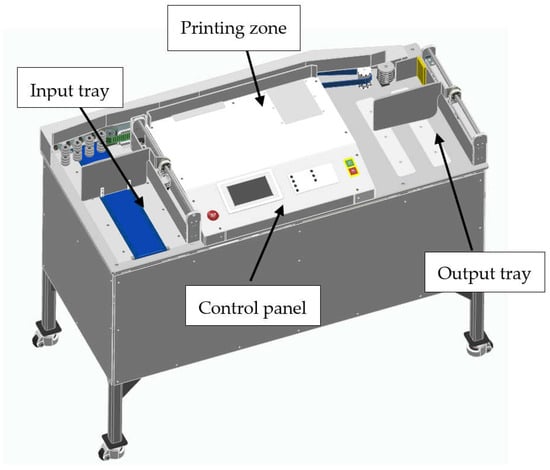
Figure 1.
Industrial postal canceling machine—3D model.
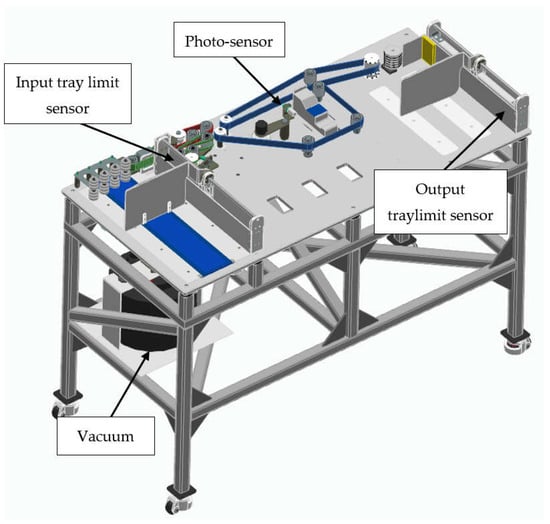
Figure 2.
Mechanical and sensor components—3D model.
2.2. Feeder Input Tray Mechanism
The feeder mechanism is responsible for the continuous and efficient entry of postal envelopes into the canceling machine. It consists of a structured system of rollers, feed belts, and adjustable guides that ensure a smooth and precise transfer of mail pieces. The mechanism is designed to handle letters various sizes and thicknesses while minimizing jams and misfeeds. The design mechanism is shown in Figure 3 and Figure 4. The mechanism is activated using a Nema 23 stepper motor with a maximum torque of 0.8 Nm.
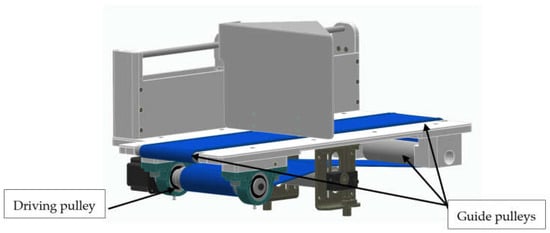
Figure 3.
Input tray upper view—3D model.

Figure 4.
Input tray bottom view—3D model.
There are three types of pulleys: driving pulley, tensor pulley, and guide pulleys.
- Driving pulley: 37.4 mm diameter.
- Tensor pulley: 39.4 mm diameter.
- Guide pulleys: 39.4 mm and 2 × 18.0 mm diameter.
2.3. Belts and Transmission Mechanism
The belts and the transmission mechanism ensure the smooth and precise movement of envelopes through the canceling machine. This system consists of a combination of drive belts, vacuum belts, and feed belts that work together to transport the mail letters at a consistent speed while maintaining proper alignment. The transmission mechanism is powered by a 0.37 kW induction motor, with a synchronism speed of 1500 rpm, which drives the belts through a series of pulleys and tensioners, ensuring efficient force distribution. It is relevant to highlight that double belt runs countersense, helping to separate and space the letters to avoid overlapping.
The characteristics of the conveyor belts integrated into the cancellation machine are detailed below in Table 1 and illustrated in Figure 5 and Figure 6.

Table 1.
Characteristics of the conveyor belts.
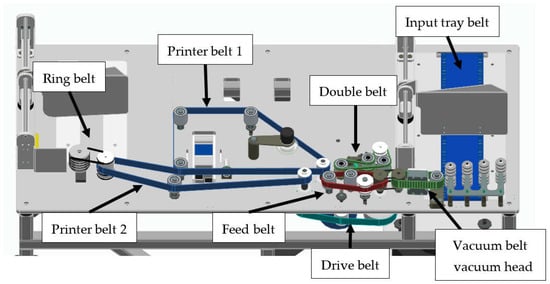
Figure 5.
Belt top view.
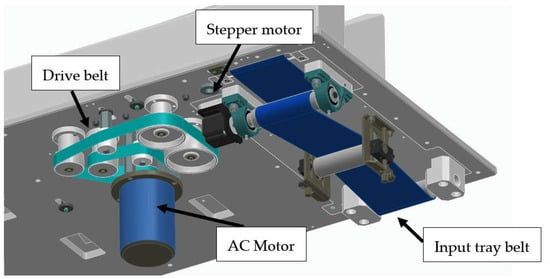
Figure 6.
Input tray stepper motor and drive belt with an AC motor.
The belt selection process required special attention, since different factors, such as linear speed, allowable tension, minimum allowed pulley diameter, friction coefficients, etc., had to be taken into consideration.
Since most of the belts did not have to carry significant payloads (considering the low weight of the letters), the required tension for each belt was experimentally defined. Each belt was tensioned to the point where it was observed to operate without any slipping, and then, tension was increased by 50% over this value to ensure a reliable operation. This way, the torque required to move the entire belt system with the AC motor was kept at a minimum. All of these tension values were measured using a challenge belt tensioning device and kept below the maximum allowed tension for each belt, as indicated in Table 1.
After all of the belts were tensioned, the torque required at each drive pulley was calculated, and considering the friction coefficient of the drive belt and the contact surface area from the belt with each pulley, a minimum tension for the drive belt was defined as follows:
The relation between the tension on both sides of the pulley is calculated as:
where T1 and T2 are the tensions on each side, µ is the friction coefficient between the belt and the pulley, and is the angle of contact in radians.
The torque transmitted can then be calculated as:
where r is the radius of the pulley.
The total tension difference (T1 − T2) calculated when considering the torque required for all of the pulleys was calculated at 80 N. Considering the motor pulley angle of contact, a tension relation of 2.12 was calculated, and thus, the maximum tension of the belt T1 was calculated at 146 N, and T2 as 66 N. The drive belt was pre-tensioned accordingly, also using a challenge belt tensioning device. These tension values are within the allowed limits for the drive belt.
2.4. Vacuum System
The vacuum system plays a crucial role in stabilizing and guiding envelopes through the canceling machine, ensuring precise positioning during processing. It consists of strategically placed vacuum belts and a suction head that create negative pressure to hold each envelope firmly against the transport surface. It also separates the envelope from the next one, helping to prevent overlapping.
After the addition of the vacuum system to the machine, a significant improvement in the overlapping rate from 1–2% of letters to an almost negligible amount. This also resulted in a significant decrease in the amount of warped letters since it prevented instances where two letters simultaneously attempted to access the separation area. Moreover, it reduced a previously observed common misalignment, consisting of letters tilting upward after being accelerated by the belts due to uneven friction with the feed belt.
2.5. Letter Capacity Analytical Model
The letter capacity analytical model estimates the maximum number of envelopes the canceling machine can process within a given timeframe, considering factors such as feeding speed, belt transmission efficiency, and processing cycle time.
Since the belts in the machine have different speeds, to allow for a reliable separation of the envelopes when two letters leave the feeding tray with minimum separation, the distance between one and the next on the printer ends up being about 0.18 m. This has been verified with high-speed cameras during testing of the machine. Given this minimum separation (), the length of the letter (), and the linear speed of the belt on the printer head (), a maximum printing rate () can be defined for each letter format, as follows:
After evaluating a significant number of samples of each letter format, an average thickness is determined for each format (). This thickness, together with the maximum printing rate, can be used to determine the frequency of the control signal supplied to the stepper motor to allow for the required feeding speed to reach this printing rate. This calculation is carried out as follows:
- Calculate the linear speed of the feeding belt (input tray).
- 2.
- Calculate the angular speed of the stepper motor, considering the radius of the pulley ().
- 3.
- Define the frequency of the control signal considering the stepper motor controller speed rate () in pulses per revolution:
Given that pushing the machine to this theoretical limit could potentially result in an increased rate of letter jamming, a more realistic letter spacing target is defined, and thus, a realistic theoretical printing rate is calculated for each of the letter formats.
In the next Table 2, the letter capacity results are shown, depending on the type of letters introduced (DL, C4, C5, C6).

Table 2.
Letter capacity analytical model calculations.
An optimal value for the final operation could be in a range between 300 and 372 mm/min, so it can handle mixed-size letters, padded letters, and more complex cases.
3. Electrical, Electronic, and Control Design
3.1. Electrical Power Supply
The electrical power system of the postal canceling machine is designed to provide efficient and safe energy supply to all electrical and electronic components involved in the process. The machine is powered through a 230 V AC, 50 Hz source, which is distributed via appropriate wiring to the various subsystems. Circuit breakers and residual current devices are included to protect against overloads, short circuits, and ground faults, ensuring the safety of both the equipment and the operator.
To supply low-voltage electronic components, a switched-mode power supply is used to convert the 230 V AC to 24 V DC. These voltages are required for the operation of sensors, actuators, and the programmable logic controller (PLC).
Power distribution is carried out through dedicated electrical buses for each voltage type (230 V AC and 24 V DC). Each bus is protected by specific fuses or circuit breakers selected according to the estimated consumption of each component.
All metallic components of the machine are connected to a proper grounding system to ensure operator safety and protect electronic equipment against electrical discharges.
3.2. Electronic and Control
The electronic and control system of the postal canceling machine is responsible for coordinating all necessary operations for the proper functioning of the cancellation process, ensuring precision and efficiency at every stage.
The electronic system consists of several essential devices that interact with each other:
- Limit switch sensors: Detect the arrival of envelopes and verify their proper alignment before printing.
- Electrical actuators: Include motors that drive envelope transport, printing mechanisms, and ejection devices.
- Communication modules: Enable signal transmission between sensors, actuators, and the programmable logic controller (PLC).
- User interfaces: Buttons, screens, or indicator lights that allow the operator to start, stop, or monitor the process.
The machine’s control is carried out by a PLC programmed to manage all tasks sequentially. The PLC program has been developed considering the following functions:
- Motion control: Regulation of motor speed and synchronization of feeding and ejection mechanisms.
- Printing control: Precise activation of printing when the envelope is in the correct position.
- Real-time monitoring: Continuous recording of sensor and actuator status for fault detection or abnormal conditions.
- Internal communication: Data exchange between the PLC and other electronic devices to maintain coordinated operation.
The design of the electronic and control circuit ensures reliable and precise performance, allowing the machine to meet the established operational and safety requirements. Figure 7 shows a diagram of power and control circuit connections.
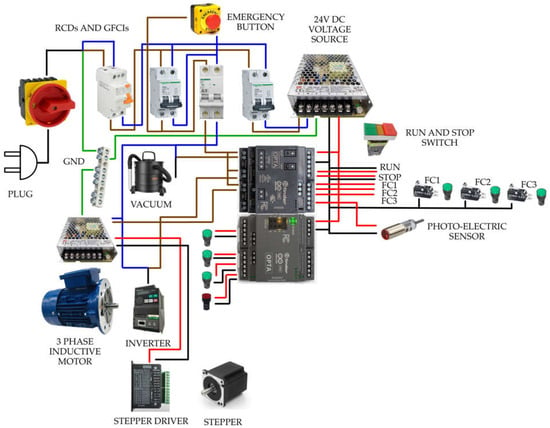
Figure 7.
The power and control connection diagram.
The control system of the canceling machine is based on a PLC that coordinates communication between sensors, actuators, and interface modules. This communication is mainly carried out through digital input/output signals, and serial communication modules for devices that require data transmission. In such cases, the UART protocol is used with a standard configuration of 9600 baud, 8 data bits, no parity, and 1 stop bit (8N1).
Sensor data are updated approximately every 20 ms, allowing for rapid response to events such as jams or full trays. This architecture ensures precise and synchronized control of the feeding, printing, and output functions, maintaining smooth and safe system operation.
3.3. Control and Safety Logic
The control and safety system of the postal canceling machine has been designed to ensure efficient and secure operation, minimizing operational risks and guaranteeing the integrity of both the equipment and the operator.
The machine’s control system is based on a programmable logic controller (PLC) that manages the operation of various subsystems, including envelope feeding, cancellation printing, and output handling. The operational logic follows a sequential scheme in which each stage must be completed correctly before transitioning to the next.
Presence and position sensors ensure that envelopes are correctly aligned before printing. Additionally, the controller monitors motor speeds and dynamically adjusts parameters to maintain stable operation. If an anomaly is detected, such as an envelope jam or excessive variation in the transport motor torque, the machine halts the process and triggers a visual and audible alert.
After a fault is detected, the system initiates a safe shutdown by stopping all motors and activating visual alarms. A message indicating the type of fault is displayed on the control panel screen to assist the operator in diagnosing the issue.
Once the problem has been physically resolved, the operator must press the start button twice to resume machine operation. This double-press mechanism has been intentionally implemented as a safety feature to ensure that the fault has been addressed and to prevent accidental reactivation. The PLC verifies that all safety conditions are restored, such as closed covers and cleared sensors, before re-enabling the sequence from the point prior to the fault.
The machine is equipped with multiple safety systems to prevent accidents and equipment damage. These include:
- Emergency stop button: Located on the front panel, it immediately cuts power to the motors and systems in case of an emergency.
- Blockage detection systems: If a jam is detected in the feeding or printing area, the machine automatically stops operation to prevent component damage.
- Mechanical protection: The machine features physical guards on all hazardous areas to prevent access to moving parts during operation.
- Presence sensors on covers and doors: If a guard is removed or a maintenance cover is opened, the machine shuts down until safe conditions are restored.
- Load control in trays: If the input tray is empty or the output tray is full, the system halts envelope processing to prevent overloading or printing failures.
The simplified sequence of the control logic is shown in Figure 8.
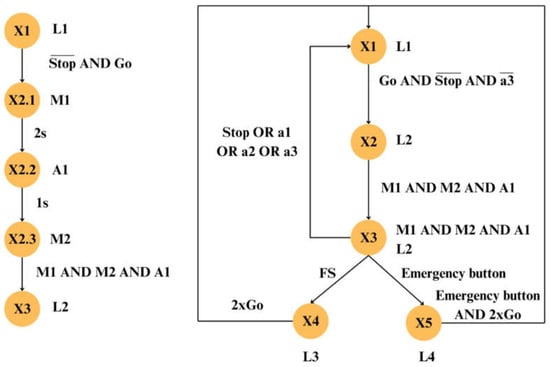
Figure 8.
The logic sequence diagram.
4. Prototype Manufacturing and Assembly
The assembly of the prototype was carried out in a specific sequence to facilitate the integration of each element. First, the base structure was assembled, securing the chassis and fixing the supports and anchor points. Next, the input tray was installed, precisely adjusted to align it with the following modules. Then, the AC motor was placed along with its conveyor belts, ensuring efficient material movement. Subsequently, the printer was integrated along with its belts, synchronizing the system to guarantee precise feeding. After that, the output tray was assembled, adjusted for the correct collection of the processed material. Finally, the sensors, wiring, and electrical box were installed, connecting each component and performing the necessary configurations.
The first step is to manufacture and assemble the machine’s structure. In Figure 9, the structure is shown before and after welding the metal profiles and the base table.
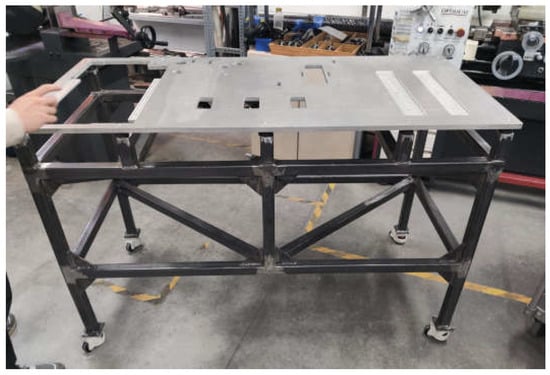
Figure 9.
The base structure.
The next step is to assemble the input tray composed by DC stepper motor, input belt, and limit switch sensor number one, as shown in Figure 10.
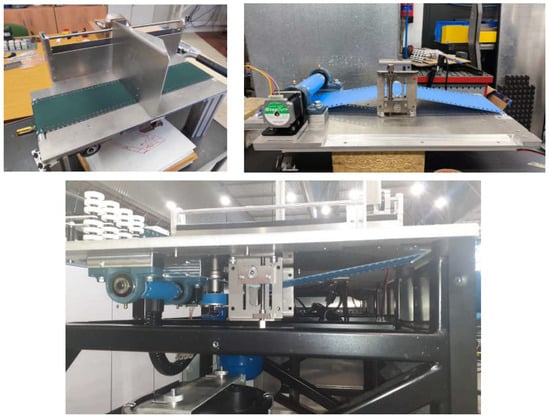
Figure 10.
The DC stepper motor, the input belt, and the limit switch sensor number one.
In Figure 11, it is shown that the third step is the installation of the AC motor, drive belt, feed belt, and vacuum belt.

Figure 11.
The AC motor, drive belt, feed belt, and vacuum belt.
The fourth step is to install the printer, printer belts one and two, the photo sensor, and the limit switch sensor number two. These components are shown in Figure 12.
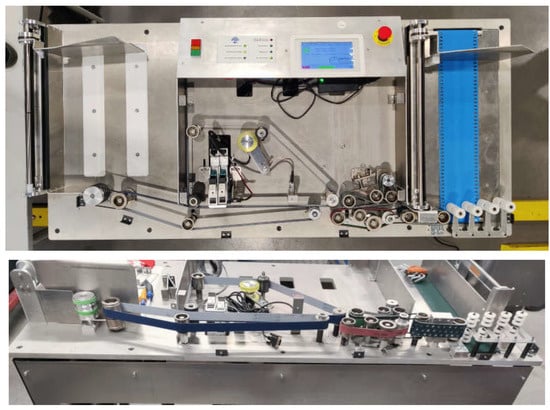
Figure 12.
The printer, printer belts one and two, the photo sensor, and the limit switch sensor number two.
The next step is to activate the output tray, as shown in Figure 13: output belt and limit switch sensor number three.
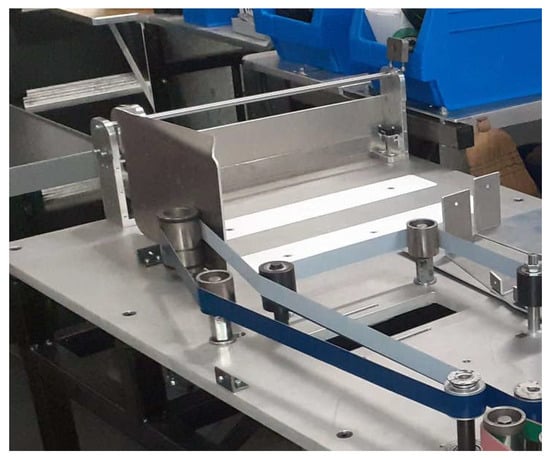
Figure 13.
The output belt and the limit switch sensor number three.
In Figure 14, the control panel—the stop and go push button, safety switch, printer control screen, and indicative LEDs—are installed on the front of the canceling machine.
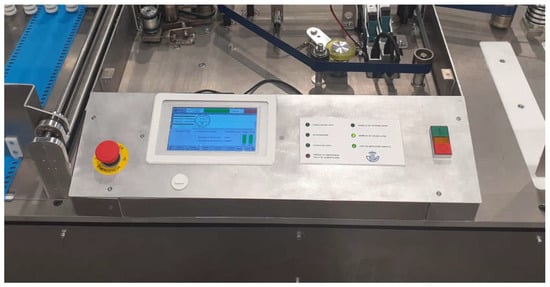
Figure 14.
The control panel.
The last step is the integration of all electric connections in the electric box, as shown in Figure 15.
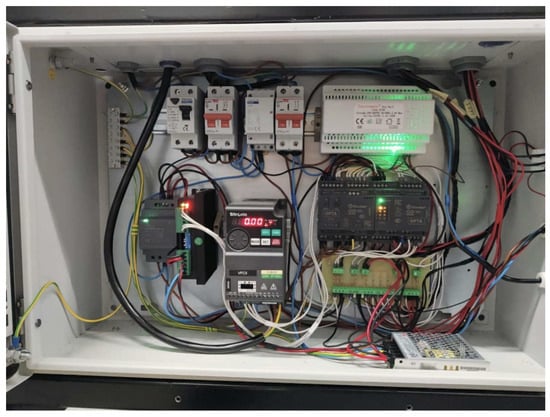
Figure 15.
The electric box.
Finally, the machine is completely assembled, installed, and ready for use, as shown in Figure 16.
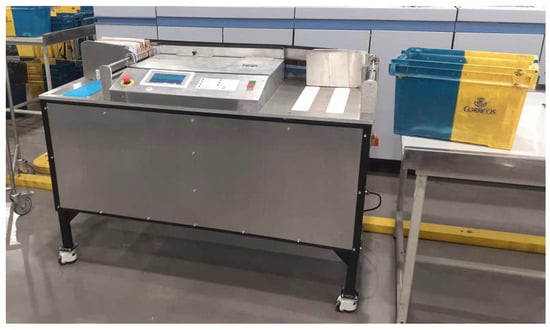
Figure 16.
A completed machine.
5. Test
5.1. Letter Canceling Capacity Test
The capacity and speed of the machine in the cancellation of envelopes have been evaluated. Different types of envelopes with different thicknesses and of different types and sizes have been evaluated. Specifically, the following types of envelopes were used: DL, C4, C5, C6, C4 padded, and C5 padded (see Figure 17).

Figure 17.
Envelope types.
For each type of envelope, the time required to cancel a certain number of envelopes was measured. Tests have been carried out at different speeds of the linear input tray and the induction motor.
- Test 1: 129 mm/min printer belts linear speed and 228 mm/min input tray belt speed.
- Test 2: 145 mm/min printer belts linear speed and 318 mm/min input tray belt speed.
- Test 3: 145 mm/min printer belts linear speed and 372 mm/min input tray belt speed.
The results can be seen in Table 3 and Figure 18. It can be seen that the best combination is the fastest one, with the fastest input tray speed. This way, the system can cancel up to 22,153 letters per hour for C6 types. There is a clear relationship between the input tray speed and cancellation capacity.

Table 3.
Capacity test results.

Figure 18.
Feeder speed vs. capacity graph.
5.2. Letter Canceling Rate
The effectiveness of cancellation for different types of envelopes and combinations has been evaluated, as shown in Table 4.

Table 4.
Cancellation rate test results.
Tests have been carried out at different speeds of the stepper motor and the induction motor.
- Test 1: 129 mm/min feed belt lineal and 228 mm/min input tray belt speed.
- Test 2: 145 mm/min feed belt lineal and 318 mm/min input tray belt speed.
Cancellation rate is almost perfect for any speed. We have only detected one exceptional overlapping case through the testing campaign.
5.3. Tests in Real Industrial Environments
In addition to the laboratory tests carried out in the previous sections, cancellation capacity tests were also conducted at the actual workstation and Sociedad Estatal de Correos y Telégrafos, S.A industrial facilities with workers. As in the previous tests, a sample of different types of letters was taken, fed into the canceling machine, and the operation time was measured. Results are shown in Table 5.

Table 5.
Capacity test results with real mixed letters.
In this case, the tests were only carried out at speeds of 145 mm/min for the printing belt and 318 mm/min for the feeder input tray belt for safety.
Results with real operative letters are lower than in the optimal laboratory test as real letters are mixed letters, mixing padded with normal letters, with a great variation of thicknesses. This prevents the use of the optimal configurations and, thus, optimal performance. In any case, the cancellation rate is always 100%. Supplementary Videos of the operation have been added to the publication.
6. Conclusions
In this work, we have described the mechanical design, analysis and tests of an innovative automatic high-speed industrial postal canceling machine. The main novelties of this machine are automatic feeding of heterogeneous letters in a very compact design, high-speed of letter processing (>22,000 letters per hour) and letter jamming detection. This is the first time that such an industrial and automatic machine is being constructed in a reduced desktop size and able to handle heterogeneous types of letters at a high-speed rate. The cancel machine includes a linear feeding belt for the letter feeding assisted by a vacuum letter gripper and a set of conveyor belts that guide the letter to impression. The machine is low energy consumption and easy to maintain with multiples safety limit switch. The design is fully compliant with the new European machines’ regulations. We show details of the mechanical design, and we present several performance and speed tests demonstrating that the machine achieves more than 99.8% of canceling rate with different sizes and thicknesses of letters, padded and mixed-size, while having a letter canceling speed of more than 22,000 letters per hour.
Supplementary Materials
The following supporting information can be downloaded at: https://www.mdpi.com/article/10.3390/machines13060455/s1, Video S1: V1—Final test—automatic feeding—mixed letters.mp4, Video S2: V2—Final test—automatic—feeding.mp4.
Author Contributions
E.D.-J. and D.L.-P. collaborated in Conceptualization, design, test and writing the article. M.F.-M., O.M.-N., A.V.-S., J.d.-O.-A. and I.V.-B. collaborated in mechanical and electric/electronic design, as well as in prototype manufacturing and assembly. B.A. have collaborated in funding acquisition, funding management, and revision of the article. All authors have read and agreed to the published version of the manuscript.
Funding
This research received funding from Sociedad Estatal de Correos y Telégrafos, S.A. under the Industrial Contract art. 60 Catedra Correos—Escuela Politécnica Superior—Universidad de Alcalá.
Data Availability Statement
Data are contained within the article.
Acknowledgments
Authors would like to thank Sociedad Estatal de Correos y Telégrafos, S.A for its financial support to the work and especially to the employees Elena Meruelo Ara, Santiago Villoria Rubio and Maria Dolores Climent Heredero for their valuable comments and suggestions during the design and project execution. We would like also to thank the technical support given by Jorge Serena Olano and Jesús Nicolás Vázquez de Miguel, both employees from Polytechnic School of Universidad de Alcalá.
Conflicts of Interest
The authors declare that this study received funding from Sociedad Estatal de Correos y Telégrafos, S.A. The funder was not involved in the study design, collection, analysis, interpretation of data, the writing of this article or the decision to submit it for publication.
References
- Bard, J.F.; Morton, D.P.; Wang, Y.M. Workforce planning at USPS mail processing and distribution centers using stochastic optimization. Ann. Oper. Res. 2007, 155, 51–78. [Google Scholar] [CrossRef]
- Yang, Y.; Bard, J.F. Internal mail transport at processing & distribution centers. IISE Trans. 2017, 49, 285–303. [Google Scholar] [CrossRef]
- Lohmann, B. Throughput control for a transport process, and an application in postal automation machines. Control Eng. Pract. 1996, 4, 1503–1509. [Google Scholar] [CrossRef]
- Chang, T.; Jeong, H.; Seo, Y.; Lee, S. A Feasibility Study on Construction of Integrated Mail Processing System. J. Korea Acad. Coop. Soc. 2007, 7, 599–605. [Google Scholar]
- Park, J.-H. A Study on the Maintenance System for Mail Sorting Machine. J. Korea Acad. Coop. Soc. 2009, 10, 3200–3206. [Google Scholar] [CrossRef]
- Iberahim, H.; Mazlinda, H.; Marhainie, M.D.; Hidayah, A.N. Determinants of Sustainable Continuous Improvement Practices in Mail Processing Service Operations. Procedia—Soc. Behav. Sci. 2016, 219, 330–337. [Google Scholar] [CrossRef][Green Version]
- Júdice, J.; Martins, P.; Nunes, J. Workforce planning in a lotsizing mail processing problem. Comput. Oper. Res. 2005, 32, 3031–3058. [Google Scholar] [CrossRef][Green Version]
- Zhang, X.; Bard, J.F. Equipment scheduling at mail processing and distribution centers. IIE Trans. 2005, 37, 175–187. [Google Scholar] [CrossRef]
- Wan, L.; Lin, F. Simulation and Experimental Study on Indentation Rolling Resistance of a Belt Conveyor. Machines 2024, 12, 778. [Google Scholar] [CrossRef]
- Čepica, D.; Frydrýšek, K.; Hrabovský, L.; Nikodým, M. Experimental and Stochastic Application of an Elastic Foundation in Loose Material Transport via a Sandwich Belt Conveyor. Machines 2023, 11, 715. [Google Scholar] [CrossRef]
- Hrabovský, L.; Nenička, P.; Fries, J. Laboratory Machine Verification of Force Transmission Provided by Friction Acting on the Drive Drum of a Conveyor Belt. Machines 2023, 11, 544. [Google Scholar] [CrossRef]
- Manin, L.; Braun, S.; Hugues, D. Modelling the belt—Envelope interactions during the postal mail conveying by a sorting machine. Stroj. Vestnik/J. Mech. Eng. 2016, 62, 463–470. [Google Scholar] [CrossRef]
- Esnoz-Larraya, J.; Valiente-Blanco, I.; Cristache, C.; Sanchez, J.; Rodriguez-Celis, F.; Diez-Jimenez, E.; Perez-Diaz, J.L. OPTIMAGDRIVE: High performance magntic gears development for space applications. In Proceedings of the 17th European Space Mechanisms and Tribology Symposium, Hatfield, UK, 20–22 September 2017; pp. 1–5. [Google Scholar]
- Diez-Jimenez, E.; Alén-Cordero, C.; Alcover-Sánchez, R.; Corral-Abad, E. Modelling and test of an integrated magnetic spring-eddy current damper for space applications. Actuators 2021, 10, 8. [Google Scholar] [CrossRef]
- Diez-Jimenez, E.; Sugiura, T.; Rizzo, R.; Gómez-García, M.J.; Fleming, A. Electromagnetic Techniques for Vibration Damping and Isolation. Shock Vib. 2019, 2019, 9139067. [Google Scholar] [CrossRef]
- Beneduce, S.; Vita, L.; Cantone, L.; Caputo, F. Machinery Regulation and Remanufacturing: A Link Between Machinery Safety and Sustainability. Machines 2024, 12, 941. [Google Scholar] [CrossRef]
Disclaimer/Publisher’s Note: The statements, opinions and data contained in all publications are solely those of the individual author(s) and contributor(s) and not of MDPI and/or the editor(s). MDPI and/or the editor(s) disclaim responsibility for any injury to people or property resulting from any ideas, methods, instructions or products referred to in the content. |
© 2025 by the authors. Licensee MDPI, Basel, Switzerland. This article is an open access article distributed under the terms and conditions of the Creative Commons Attribution (CC BY) license (https://creativecommons.org/licenses/by/4.0/).